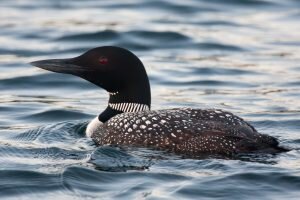
The common loon is preparing to return to its summer home and find a mate, but not before ditching its winter feathers, left, for slick new breeding plumage, right.
By Brian Gilliland, Associate Editor
(April 27, 2018) While it may have crept up on longtime attendees and some of the organizers, it’s once again the weekend in Ocean City where birds rule as the Ward Museum of Wildfowl Art showcases the world’s best in wildfowl carving, while the Delmarva Birding Weekend focuses on the diversity and depth of the actual avian population found here on the shore.
This year’s spring Delmarva Birding Weekend is all about transitions, as the birds that winter here are preparing to head back to the north, while those that spend the winter in the south are starting to come in.
“All of our little buddies from the Caribbean and the tropics, along with South American populations are zipping through,” Jim Rapp, event organizer, said.
Though the migrant population is either preparing for or finishing up a long journey, they also have mating on their minds as winter turns to spring.
“Everyone is feathering out for spring breeding, and they look spectacular — like they have on a new set of clothes,” Rapp said.
Like the tourists and semi-permanent residents who will begin showing up on these shores in the next few weeks, the birds want to look their best as the search for a mate begins. After sporting the same coat of feathers for the entire winter of slush, snow, mud and rain, the new coat of feathers coming in now are fresh, clean and, in many cases, eye catching.
“Loons and grebes can look very bland in the winter,” Rapp said. “Over the next short while they’ll begin to feather out and they’ll look like they’ve been painted.”
Rapp’s partner in putting on the Delmarva Birding Weekend, Dave Wilson, agrees.
“Loons in breeding plumage are so beautiful. During the winter they’re just this mottled black and white, but they’ll get patterns before they leave,” he said.
Common loons will acquire a striped ring around their necks along with complicated crisscross patterns on the backs of their wings when it comes time to breed.
Yellow-rumped warblers will go from a light brown in winter to bright blue that also showcases the yellow highlights found on their heads, breasts, and yes, hindquarters better than their winter plumage.
“All of our waders are arriving now: tri-colored herons, little blue herons, white ibis, great blue herons, glossy ibis and black crowned night herons,” Wilson said.
The Delmarva Birding Weekend is organized the same way it has been for the past few years, where guests and visitors can register for trips online at delmarvabirding.com.
Today, Friday, there are trips scheduled at the Prime Hook National Wildlife Refuge in Delaware, a boat tour off Fisherman’s Wharf in Delaware and a meet-up at Irish Eyes following the boating trip and a kayaking excursion off Ayres Creek.
There is one event scheduled for Saturday and three others this Sunday.
As most of these trips are outdoors, weather-appropriate gear is recommended, along with sunscreen and rain attire as well. Only severe, dangerous weather will cancel a trip, Rapp said.
Most trips are too intense for smaller children, Rapp warns.
For more information, visit www.delmarvabirding.com.
